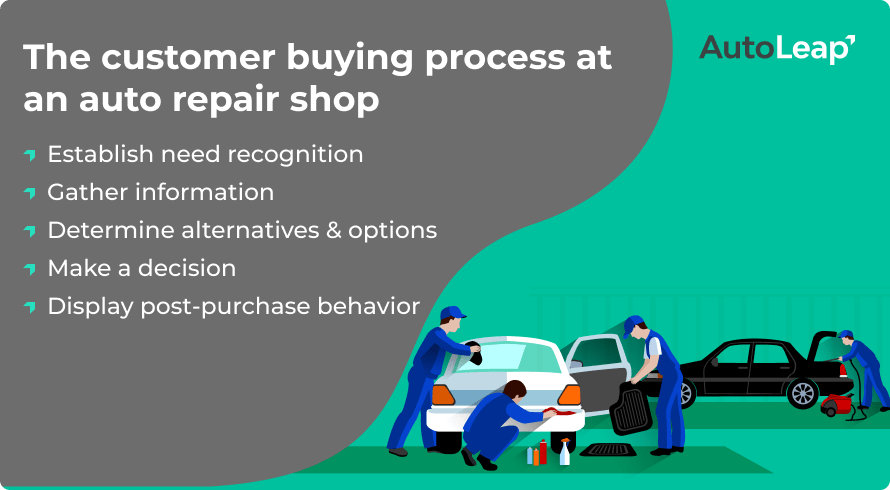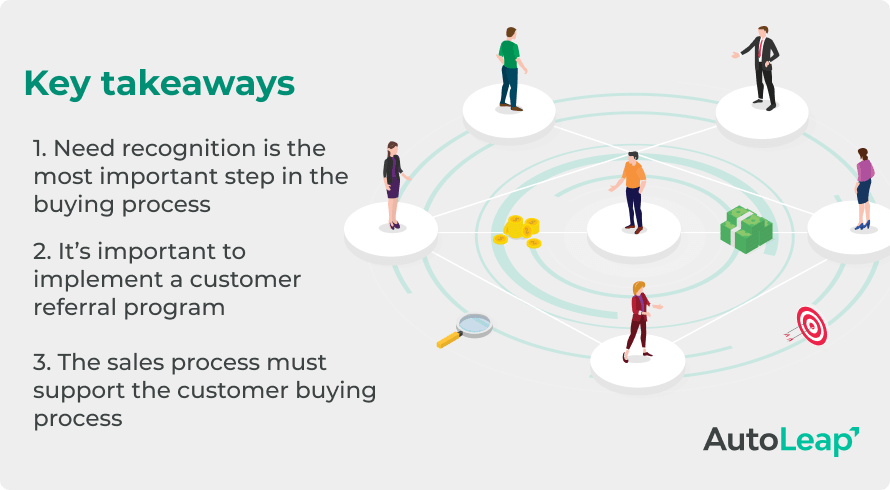During Greg Marchand’s 15-year tenure at Toyota, he noticed something—most auto repair shops focus solely on the sales process. And not just that, but everyone has a different approach to selling their services.
“There’s not a bad sales process out there,” says Marchand, president of Automotive Aftermarket Training. “They’re all similar in certain ways and all different in other ways. But the one thing they all have in common is they have to engage the customer.”
» Want to grow your auto repair business? Click here to schedule a demo.
So, what if the auto industry focused on the customer journey instead? That’s exactly what Marchand recommends. He studied decades of customer journey research and distilled it into the five most important steps, which he shared in a recent webinar hosted by auto repair management software provider, AutoLeap.
Learning the buying process gives auto repair professionals a jumpstart in delighting customers and closing more sales.

Step #1: Establish need recognition
Every customer’s journey begins with realizing that they need something. “If a customer is not at [the] need recognition [stage], they’re not in the buying process,” says Marchand.
He provides the example of a customer getting an oil change. They recognized a need—the car needed new oil. But when the technician informs the customer the brakes also need to be replaced, the customer declines. In this case, the technician skipped the first step of the buying process because the customer lacked need recognition for replacement brakes.
However, Marchand explains that unless a customer identifies they need something, they’re unlikely to buy whatever you’re selling. “Before any of us makes a purchase, we’ve got to feel like this is something that’s going to solve something… Or we’re going to feel like, ‘You are trying to sell me something I don’t need.’”
How do you get a customer to recognize a need?
“It doesn’t take a whole lot to plant the seeds of need recognition,” says Marchand. “Show and tell is really powerful because the customer’s looking at their own automobile, and they’re hearing you explain what’s wrong. They’re seeing it. And even if they don’t know what they’re looking at, they know something doesn’t look right, and it’s creating need recognition with them.”
Once a customer recognizes a need, they enter the next step of the buying journey. Digital vehicle inspections (DVI) are an excellent tool to show customers what they need. Shop owners can send them videos and photos, coupled with voice memos to explain why a repair is important. Marchand recommends educating customers in three ways:
- Verbally: Explain what the problem is to customers in simple terms, so they know you’re trying to help them
- Visually: Stand in front of the car and point to worn-out parts that may cause concern for the customer. Additionally, print out an inspection report and highlight damaged components in red to increase transparency with customers
- In writing: Some people understand things better when they see them on paper, so make sure you make a list of the problems and possible solutions and present it to the customer
To maximize profits at your mechanic shop, it’s important to have a proper sales process that service advisors use when talking to customers and addressing their needs.

Step #2: Gather information
Now the customer begins gathering information. So, where do they go? According to Marchand, customers turn to “Uncle Google,” friends, family, and colleagues.
How can auto repair techs ensure they’re considered in this process?
“The customer standing at your service counter is a friend, family member, or coworker of somebody,” says Marchand. “And so you actually, as a service advisor, have influence over people you don’t even know yet, customers that haven’t gone to you yet.”
To influence existing customers to recommend your services, consider a customer referral program. Marchand recommends printing business cards with your logo and program name on the front and a line on the back for your customer’s name. Whenever that customer knows someone in the need recognition phase for car repair, they can give them that card. Once a card comes through your door, you credit that customer $50 for the referral.
Even if your company uses a robust marketing program that includes direct mail, newspaper inserts, radio ads, social media, and more, you should institute a customer referral program and ensure it’s properly communicated to every customer.
Why? Because a customer referral program is the only marketing you don’t need to pay for until the next customer comes in. So even if you pay your current customer $50, you’re trading that money for your shop’s average repair cost.
Step #3: Determine options and alternatives
In the third step of the customer buying process, customers determine options and alternatives. To help customers in this step, educate them on their available choices. Sometimes a wide variety of options exist—take tires, for example. But what about when your customer needs a catalytic converter?
It’s important to note that there aren’t many options for some parts. Catalytic converters are expensive, and nobody wants to compromise on quality. In such cases, you can offer financing options.
What alternatives can you provide to the customer?
Consider presenting these options:
- Financing
- Payment plans
- Priority-tiered approach (perform some work now, some later)
- Value-adds (including warranties, road hazard programs, roadside assistance, and satisfaction guarantees)
- Convenience options (including loaner cars, rental cars, rides)
Providing your customer with alternatives and options helps you reach the next step in the buying journey—the decision or sale. In the video below, Marchand talks about one option that shops often fail to consider.
Step #4: Make a Decision
Once the customer knows their needs and what the options and alternatives are, they’re ready to make a decision.
If your shop asks for a sale and the customer says no, go back to the buying process.
Did you explain their needs correctly? Did you provide the information visually and in writing to match different learning styles? Did you offer enough options and alternatives? Are there any value adds or conveniences you can provide to close this sale? You must empower your shop employees to meet the customer at every step of the buying journey.
Once you close a sale, the customer enters the final step of the buying process.
Step #5: Display post-purchase behavior
There’s always a post-purchase behavior, and it depends on whether the customer leaves satisfied with their service or angry about the money and time spent. You want to influence the customer’s post-purchase behavior to be:
- Increased referrals to your shop
- More positive Google reviews
- Customer returns to your shop
How do you influence this post-purchase behavior?
Remind the customer of the value of their purchase. “Sell the job again, sell the value again, sell the assurance that I’m not going to have any more problems with whatever I brought to you to have repaired,” says Marchand.
Then, ask for referrals (don’t forget that referral program!) and reviews, before scheduling the next appointment.
Closing thoughts

“The best thing you can do is ask yourself, ‘Where in the customer buying process, as that customer stands in front of me today, is that customer?’” says Marchand.
By recognizing the psychology behind the buying process, we can close and delight more customers. With this understanding, you can tailor your sales process to match the step they’re in, whether it requires educating them on the need or sharing options and alternatives.









